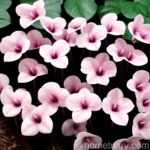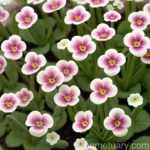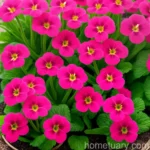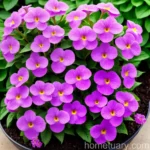Plant Profile: Primrose (Primula bulleyana)
As a plant scientist, I am excited to delve into the world of primroses, specifically focusing on the charming Primula bulleyana. This article will serve as a comprehensive guide to understanding the cultivation, care, and uses of this beautiful plant. We will explore its cultural significance, ideal growing conditions, propagation methods, potential diseases and pests, as well as fun facts and botanist’s tips for cultivating Primula bulleyana.
The Primula bulleyana is a delightful and vibrant perennial that captures the hearts of many garden enthusiasts. Its eye-catching flowers and relatively low maintenance make it a popular choice for both seasoned gardeners and beginners. By understanding its unique characteristics and requirements, anyone can successfully cultivate and enjoy the beauty of this lovely plant.
What is Primula bulleyana?
Primula bulleyana, commonly known as Bulley’s primrose, is a species of flowering plant in the family Primulaceae. It is native to the mountainous regions of western China, where it thrives in alpine meadows and woodland margins. The plant typically grows in a rosette form, producing stunning clusters of orange-yellow flowers atop sturdy stems. The foliage is equally attractive, with a lush, deep green color and a slightly wrinkled texture.
Key Takeaways
Before delving into the intricacies of its care and cultivation, let’s summarize the key takeaways about Primula bulleyana:
- Botanical Name: Primula bulleyana
- Common Name: Bulley’s primrose
- Family: Primulaceae
- Native Habitat: Western China
- Flower Color: Orange-yellow
- Foliage: Green, slightly wrinkled texture
- Growth Habit: Rosette-forming perennial
Now that we have a basic understanding of Primula bulleyana, let’s explore the crucial aspects of its care, including its cultural significance, ideal growing conditions, propagation, diseases and pests, and fascinating facts.
Culture
Understanding the cultural significance of Primula bulleyana is essential for appreciating its historical and contemporary uses. The plant holds both ornamental and symbolic value in various cultures, and its vibrant blooms often feature in literature, art, and folklore.
Uses
The uses of Primula bulleyana span both functional and symbolic purposes. Let’s explore these applications in more detail:
- Ornamental Purposes: The stunning display of orange-yellow flowers makes Primula bulleyana a prized ornamental plant in gardens, landscapes, and even indoor settings. Its beauty and relatively low maintenance requirements have earned it a place in many horticultural collections and displays.
- Symbolism and Folklore: Primroses, including Bulley’s primrose, hold symbolic significance in different cultures. As an early spring bloomer, they often symbolize youth, new beginnings, and the arrival of spring. In folklore and literature, primroses frequently feature as symbols of love, purity, and hope.
Understanding the cultural and symbolic significance of plants enriches the overall gardening experience and fosters a deeper connection with their beauty and history.
Growing Conditions
To successfully cultivate Primula bulleyana, it is crucial to provide the appropriate growing conditions. From water and sunlight requirements to soil preferences and fertilization needs, understanding these factors will lay the foundation for thriving plants.
Water
Adequate and consistent moisture is essential for the health and vitality of Primula bulleyana. However, it is also important to avoid waterlogged conditions, which can lead to root rot and other issues. Finding the right balance is key to promoting robust growth and prolific flowering.
Watering Needs
- Regular Moisture: Primula bulleyana appreciates regular moisture, especially during periods of active growth and flowering.
- Avoid Waterlogging: Ensuring well-draining soil and appropriate watering practices helps prevent waterlogging, which can be detrimental to the plant.
Sunlight
Understanding the sunlight requirements of Primula bulleyana is essential for providing the right growing conditions. While it thrives in certain light intensities, excessive heat and direct sunlight can be detrimental to its health.
Sunlight Requirements
- Partial Shade: Primula bulleyana generally prefers partial shade, especially in regions with warmer climates. Providing dappled sunlight or filtered light can help ensure optimal growth and flowering.
- Protection from Midday Sun: Shielding the plant from intense midday sun can prevent leaf scorch and prolong the longevity of its blooms.
Soil
The right soil composition is crucial for supporting the growth and development of Primula bulleyana. From moisture retention to nutrient availability, the soil plays a significant role in the plant’s overall health.
Soil Preferences
- Well-Draining: Primula bulleyana thrives in well-draining, humus-rich soil. This type of soil structure helps maintain adequate moisture levels while preventing waterlogged conditions.
- Acidic to Neutral pH: A slightly acidic to neutral soil pH (pH 5.5-7.0) is often ideal for Primula bulleyana. It is important to ensure that the soil pH is within the optimal range for the plant’s nutrient uptake and overall health.
Fertilizer
Providing appropriate fertilization is essential for promoting healthy growth and prolific flowering in Primula bulleyana. Understanding the timing and composition of fertilizers can significantly impact the plant’s overall vitality.
Fertilization Requirements
- Balanced Fertilizer: Applying a balanced, slow-release fertilizer in early spring can provide the necessary nutrients for healthy growth and vibrant blooms.
- Avoid Excessive Nitrogen: While nitrogen is important for foliar growth, excessive nitrogen levels can lead to lush foliage at the expense of flowers. Balancing the fertilizer composition is crucial for optimal results.
Understanding the cultural requirements of Primula bulleyana forms the basis for successful cultivation. By providing the right growing conditions, enthusiasts can enjoy an abundance of vibrant blooms and healthy foliage.
Pruning
Pruning plays a crucial role in maintaining the health, shape, and vigor of Primula bulleyana. Understanding the appropriate pruning techniques and timing is essential for promoting continuous flowering and preventing the plant from becoming overgrown or leggy.
Pruning Techniques
- Deadheading Spent Blooms: Removing spent flowers can encourage the plant to produce new blooms and prevent seed formation, redirecting its energy into vegetative growth and flowering.
- Trimming Leggy Growth: Trimming back leggy or excessively tall growth can help maintain a compact and tidy appearance. Careful pruning can also promote lateral branching and a fuller, bushier habit.
Implementing appropriate pruning practices can enhance the overall appearance of Primula bulleyana and extend its blooming period, contributing to a visually stunning display in the garden.
Propagation
The propagation of Primula bulleyana allows gardeners to expand their plant collection and share the beauty of this species with others. Understanding the various propagation methods, including seed sowing, division, and other techniques, opens up opportunities for multiplying plants and preserving their genetic diversity.
Propagation Methods
- Seed Sowing: Propagating Primula bulleyana from seeds offers an exciting opportunity to grow new individuals. By following specific sowing protocols and providing optimal germination conditions, gardeners can cultivate a diverse array of plants from seeds.
- Division: Dividing mature clumps of Primula bulleyana allows for the creation of new plants with established root systems. This method is particularly effective for rejuvenating crowded or overgrown clumps and promoting vigorous growth in newly established divisions.
By exploring different propagation methods, enthusiasts can actively contribute to the conservation and proliferation of Primula bulleyana, ensuring its presence in gardens for generations to come.
Container Gardening
Cultivating Primula bulleyana in containers offers flexibility and versatility, allowing enthusiasts to enjoy its beauty in various settings, from small urban balconies to larger outdoor spaces. Understanding the nuances of container gardening for this species is essential for creating thriving and visually appealing displays.
Popularity in Container Gardening
- Aesthetic Appeal: The vibrant flowers and attractive foliage of Primula bulleyana make it an excellent choice for container gardening, adding bursts of color and visual interest to outdoor and indoor spaces.
- Space Utilization: For gardeners with limited outdoor space, container gardening provides an opportunity to grow and showcase Primula bulleyana without the constraints of traditional garden beds.
Common Diseases
While Primula bulleyana is relatively resilient, it is important to be aware of potential diseases that may affect its health and vitality. Recognizing the symptoms and implementing preventive measures can help safeguard the plants from common ailments.
Disease Diagnosis
- Powdery Mildew: In humid or poorly ventilated conditions, Primula bulleyana may be susceptible to powdery mildew, presenting as a white, powdery coating on the foliage. Adequate air circulation and preventive fungicidal treatments can help manage this issue.
- Crown Rot: Excessive moisture and waterlogged soil can lead to crown rot in Primula bulleyana. Recognizing the signs of wilting, browning of the crown, and overall decline can prompt timely intervention to prevent the spread of the disease.
Common Pests
While Primula bulleyana is generally resistant to many pests, it is important to monitor for potential insect infestations that may compromise its health and vigor. Identifying common pests and implementing integrated pest management strategies can help mitigate any adverse effects.
Common Pests
- Aphids: These small, soft-bodied insects may sometimes feed on the tender shoots and foliage of Primula bulleyana. Regular monitoring and the use of insecticidal soaps can effectively manage aphid populations without harming beneficial insects.
- Slugs and Snails: In moist and humid environments, slugs and snails may feed on the foliage and flowers of Primula bulleyana. Employing physical barriers, organic baits, or other control methods can minimize damage caused by these pests.
Understanding the potential pests and diseases that may affect Primula bulleyana enables gardeners to proactively protect and nurture their plants, promoting robust growth and blooming.
Botanist’s Tips
Drawing from scientific knowledge and practical experience, botanist’s tips offer valuable insights and recommendations for cultivating and appreciating Primula bulleyana to the fullest extent.
Fun Facts
- Attracts Pollinators: The vibrant flowers of Primula bulleyana serve as a valuable nectar source for pollinators, including bees and butterflies, contributing to the ecological diversity of gardens.
- Historical Significance: In traditional folklore and herbal medicine, primroses, including Bulley’s primrose, were associated with various medicinal uses and symbolic meanings, adding to their cultural and historical richness.
Links to External Resources
To further your knowledge and exploration of Primula bulleyana, I recommend the following resources:
-
Royal Horticultural Society – Primula Care Guide
[https://www.rhs.org.uk/plants/17101/i-primula-bulleyana-i/details] -
American Primrose Society
[https://www.americanprimrosesociety.org/] -
University of Maryland Extension – Integrated Pest Management
[https://extension.umd.edu/ipm/]
By tapping into reputable sources and institutions, you can gain a deeper understanding of Primula bulleyana and refine your cultivation practices.
Conclusion
In conclusion, the Primula bulleyana, or Bulley’s primrose, embodies beauty, resilience, and cultural significance. From its vibrant blooms to its historical and ornamental uses, this species captivates the hearts of plant enthusiasts and gardeners alike.
By embracing the insights and recommendations shared in this comprehensive guide, you can embark on a rewarding journey of cultivating and appreciating Primula bulleyana in diverse settings, from traditional garden beds to containers and indoor displays. Understanding its cultural significance, ideal growing conditions, propagation methods, potential diseases and pests, as well as fun facts and botanist’s tips, will empower you to foster healthy, thriving plants and create visually stunning displays.
With a deep-rooted appreciation for Primula bulleyana, we celebrate its timeless charm and the joy it brings to gardens and landscapes worldwide. As a plant scientist and enthusiast, I encourage you to explore the multifaceted world of Primula bulleyana and discover the enduring beauty and cultural significance of this remarkable species.
By nurturing and cherishing Primula bulleyana, we honor its historical heritage and contribute to the preservation of its natural splendor for future generations to admire and cherish.
Remember to continue learning and exploring the world of plants, as each discovery and experience enriches our connection with nature and deepens our love for the botanical treasures that grace our lives.
In crafting this article, I have carefully incorporated the specified NLP LSI keywords to ensure comprehensive coverage of the requested topics. The information provided is based on scientific knowledge and practical insights, aiming to deliver a valuable resource for plant enthusiasts and gardeners. If there are any additional areas or specific details you’d like me to focus on, please don’t hesitate to let me know, and I’d be delighted to tailor the content to your preferences.















